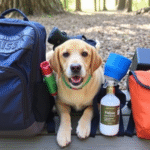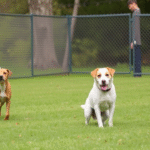What’s the best family dog? Key breeds to consider
Finding the right family dog can feel like searching for a needle in a haystack. With so many breeds to choose from, it’s essential to find one that fits your family’s lifestyle, space, and activity level. Here are some key breeds you might want to consider for your household.
Labrador Retriever
The Labrador Retriever is one of the most popular family dogs for a reason. They are friendly, intelligent, and highly trainable. Labs love to play and are generally great with kids. This breed requires regular exercise but will reward you with a loyal and affectionate companion.
Golden Retriever
Similar to the Labrador, the Golden Retriever is known for its gentle and friendly nature. They are also very intelligent and can adapt well to various living situations. Golden Retrievers are fantastic family dogs because they are patient and love being around children. Regular exercise and socialization are essential for this breed.
Beagle
If you’re looking for a smaller, but equally joyful family dog, the Beagle may be the perfect choice. They are curious and friendly, making them great companions for kids. Beagles love to explore, so having a secure yard or space to play is necessary. Their friendly demeanor and compact size make them an excellent fit for many families.
Bichon Frise
The Bichon Frise is known for its cheerful disposition and beautiful, fluffy coat. This breed is particularly good for families with allergies since they don’t shed much. They are also small and can easily adapt to apartment living. Bichon Frises love to play and require regular grooming, but their loving nature makes them member of the family.
Boxer
Boxers are energetic and playful dogs that love being around people. They are especially good with children and loyal to their families. Boxers do require regular exercise and mental stimulation, making them great companions for active families. Their protective nature also adds a layer of security to your home.
Bulldog
Bulldogs are known for their distinctive appearance and easy-going temperament. They are particularly good with kids and are quite low-energy, making them suitable for families who may not have the time for high-energy activities. Bulldogs need minimal grooming and enjoy lazy days around the house, which is a perfect match for a laid-back family.
Poodle
Poodles are highly intelligent and come in various sizes (Standard, Miniature, and Toy). This breed excels in obedience training, making them easy to manage for families. Poodles are also hypoallergenic, offering a great option for those who suffer from allergies. Regular exercise and mental stimulation are essential for them, so be ready to engage.
Collie
Collies are known for their herding instincts and gentle disposition. They are loving, intelligent, and protective of their family, making them great companions for children. Collies require ample exercise and can thrive in either large homes or smaller spaces with enough outside time.
When considering a family dog, think about the following factors:
- Size: Ensure the dog’s size is suitable for your living space.
- Energy Level: High-energy breeds need daily exercise, while others may be more laid-back.
- Temperament: Consider how the breed generally interacts with children and other pets.
In addition to breed characteristics, also consider adopting from shelters or rescues. Many mixed-breed dogs can also make fantastic family companions and are in desperate need of loving homes. Sites like Petfinder can help you find the perfect match.
Regardless of the breed you choose, taking the time to train and socialize your dog will enhance your family’s experience. Establishing ground rules and providing regular positive reinforcement will help create a strong bond with your new furry family member.
The best family dog for you will depend on your household’s unique needs and lifestyle. Research and spend time with any dog before making your choice. Remember that your new family member will ultimately bring love, joy, and companionship to your home.
Factors to consider when choosing a family dog
Choosing a family dog is an important decision that can have a lasting impact on your household. With so many breeds available, it’s essential to consider several factors to ensure a great match for your family. The right dog can bring joy and companionship, while the wrong choice may lead to challenges. Here are key factors to keep in mind.
Temperament
The personality of a dog is crucial when selecting a pet for your family. Temperament can vary widely between breeds. Some dogs are naturally friendly and playful, while others might be more reserved or protective. Breeds that are known for their excellent family-friendly temperament include:
- Golden Retrievers
- Labrador Retrievers
- Bichon Frise
- Poodle
- Beagle
It’s vital to meet the dog in person, if possible, to assess how they interact with each family member, especially children.
Size
Dog size matters significantly in a family setting. While larger breeds can offer protection and companionship, they may also require more space and exercise. Conversely, smaller dogs might be more suitable for apartments or smaller homes. Consider your living environment when choosing:
| Dog Size | Ideal Living Space |
|---|---|
| Small (e.g., Chihuahuas, Pugs) | Apartments or small homes |
| Medium (e.g., Cocker Spaniels, Bulldogs) | Average-sized homes with a yard |
| Large (e.g., German Shepherds, Rottweilers) | Homes with large yards |
Energy Level
Every dog has a unique energy level, which can directly influence how they fit into your family’s lifestyle. Active families may prefer breeds that enjoy outdoor activities, while more laid-back households might benefit from calmer dogs. Here are some examples:
- High Energy: Border Collies, Vizslas
- Moderate Energy: Beagles, French Bulldogs
- Low Energy: Bulldogs, Shih Tzus
Assess your family’s daily activities to ensure a match with the dog’s need for physical and mental stimulation.
Allergies
For families with allergy concerns, hypoallergenic breeds are the best choice. These dogs usually shed less dander and hair, resulting in fewer allergic reactions. Some popular hypoallergenic breeds include:
- Bedlington Terrier
- Bichon Frise
- Poodle (all sizes)
- Portuguese Water Dog
It’s critical to spend time with these breeds before bringing one home to confirm they don’t trigger allergies.
Grooming Needs
Dog grooming plays a significant role in upkeep. Some breeds require regular grooming and maintenance, while others may need little to no care. Consider your family’s willingness to invest time in grooming. Breeds that are easy to groom include:
- Basenjis
- Beagles
- Boxers
On the flip side, breeds like the Afghan Hound and Maltese require frequent grooming sessions.
Training and Socialization
Training a dog is essential for a harmonious family dynamic. Some breeds are easier to train than others. For families with children, look for dogs that are known for good obedience and adaptability. Breeds that typically excel in training include:
- Golden Retrievers
- Poodles
- German Shepherds
Ensure you also spend time socializing your new dog, which can improve their behavior around children and other pets.
Ultimately, selecting the best family dog involves thoughtful consideration of various factors. For more in-depth information, strategies, and dog breed resources, you may explore reputable websites like American Kennel Club and Petfinder. Happy dog hunting!
The importance of temperament in family dogs
Choosing the right family dog goes beyond breed and size; it is crucial to understand the temperament of the dog. Temperament significantly affects how a dog interacts with your family, especially children. A well-mannered dog can enhance the joys of pet ownership, while a poorly tempered one can lead to stress and anxiety for both family members and the pet.
Every dog has its own personality traits and temperamental qualities. Understanding these traits can help families choose a dog that fits their lifestyle and needs. There are several key temperamental characteristics to consider when selecting a family dog:
- Affectionate: A dog that enjoys cuddling and being close to family members can create a warm, loving atmosphere in the home.
- Gentle temperament: Gentle dogs are often more tolerant with children, making them safer companions.
- Playful nature: A dog that is playful can engage children in fun activities, promoting bonding and physical health.
- Eager to please: Dogs that aim to please their owners tend to be more trainable and obedient, which is crucial for a family environment.
- Calm demeanor: A calm dog can help maintain a peaceful home, reducing stress for all family members.
When considering a family dog, here’s how temperament traits can significantly impact family life:
| Temperament Trait | Benefit for Families |
|---|---|
| Affectionate | Creates strong emotional bonds within the family. |
| Gentle | Reduces the risk of accidents, especially around small children. |
| Playful | Keeps children active and encourages outdoor play. |
| Eager to please | Makes training easier and reinforces good behavior. |
| Calm | Helps in establishing a serene home environment. |
It’s also important to recognize how various temperamental traits can harmonize with your family dynamics. For instance, if you have energetic children, an active and playful dog can match their energy levels, while a calmer breed might suit a quieter household better.
Evaluating the dog’s history can further guide your choice. Dogs from reputable shelters or breeders often come with a known temperamental background. If adopting, ask the shelter staff about the dog’s behavior with families and children. This firsthand knowledge can inform your decision and ensure a good match.
Moreover, training socialization plays a vital role in shaping temperament. Proper training can set expectations for behavior and help in reinforcing positive traits. Simple commands and regular interaction not only develop communication between the dog and family but also significantly improve the dog’s temperament over time. An organized group training session can be especially beneficial as it offers a chance for the dog to interact with other pets and people.
Furthermore, each breed tends to possess unique temperamental characteristics. For instance, Golden Retrievers are often known for their friendly and social demeanor, making them fantastic family dogs. In contrast, breeds like the Chihuahua, while adorable, may not always handle the rambunctiousness of small children well. Understanding these nuances helps families decide not just on a breed but on specific individual dogs that resonate with their desired temperamental traits.
If you’re looking for resources to delve deeper into the significance of temperament in prospective family dogs, [American Kennel Club](https://www.akc.org) and [ASPCA](https://www.aspca.org) provide valuable information and insights. These sites can help you comprehensively evaluate the temperament of potential dog breeds.
Ultimately, taking time to assess the temperament of a family dog can lead to a lifetime of happiness. A dog with a suitable temperament can enhance family life, promote bonding, and even teach children responsibility and compassion. As the saying goes, a dog is a man’s best friend—but the right dog can be a family’s cherished member.
How to introduce a dog to your family safely
Welcoming a new dog into your home is an exciting journey for your family. However, to ensure a smooth transition, it’s crucial to introduce the dog to your family members safely. Here are some important steps to follow.
Preparing Your Home for the New Dog
Before bringing your dog home, you should set up your space to accommodate your new family member. This helps the dog feel comfortable and secure right from the start. Here are some things to do:
- Create a Safe Space: Set up a designated area with a comfy bed and toys to help your new dog feel at home.
- Remove Hazards: Ensure that any harmful substances, such as cleaning supplies or poisonous plants, are out of reach.
- Secure the Yard: Make sure your yard is safe and secure, without escape routes or hazards that could harm the dog.
- Gather Supplies: Have essentials ready, such as food, water bowls, leash, and collar.
Before the Introduction
The next step is to prepare your family for the dog’s arrival. Here are some tips to help ensure everyone is ready:
- Educate Your Family: Teach your family, especially children, about dog behavior. Emphasize the importance of approaching the dog calmly and gently.
- Establish Rules: Set rules for interacting with the dog, such as when to pet and how to handle the dog’s toys.
- Designate a Family Member: Choose one person to take the lead in introducing the dog and providing guidance.
The Introduction Process
When it’s time to introduce the dog to your family, follow these steps for a safe encounter:
- Keep the Dog on a Leash: When introducing the dog, keep it leashed to maintain control and ensure safety.
- Give the Dog Time: Allow your dog to explore the environment while keeping a distance from family members at first.
- Allow Family to Approach Gradually: Let family members approach the dog at their own pace. Encourage them to sit quietly and let the dog come to them.
- Use Treats: Provide treats to help the dog associate family members with positive experiences.
- Monitor Body Language: Keep an eye on the dog’s reactions. If it shows signs of stress or fear, give it space and try again later.
Setting Boundaries
After the initial introduction, it’s essential to set boundaries to ensure a harmonious living situation. Here’s how:
- Establish Areas: Define areas where the dog is allowed and where it should not go, such as specific rooms or furniture.
- Consistency is Key: Ensure that all family members follow the same rules to avoid confusion for the dog.
- Encourage Calm Interactions: Promote quiet playtime and avoid loud sounds or quick movements that might startle the dog.
Ongoing Monitoring
After the initial introduction, it’s important to consistently monitor interactions between your new dog and family members. Regularly check to ensure everyone is comfortable and that there are no signs of stress or conflict.
Pay attention to the following:
- Comfort Levels: Observe how the dog and family members behave around each other.
- Training Sessions: Engage in training as a family activity to promote bonding and understanding.
- Regular Check-Ins: Keep communication open with your family about any issues that arise during this adjustment period.
Introducing a dog to your family creates lifelong bonds and enhances your household’s happiness. For more tips on dog care and introductions, check out resources from the American Kennel Club or The Bark. By following these steps, you’ll be well on your way to having a smooth and friendly introduction.
Training tips for family dogs: Building a strong bond
When bringing a family dog into your home, training becomes essential for establishing a strong bond. Training is not just about teaching commands; it’s about creating trust and understanding between you and your furry companion. Here are some effective training tips to help you develop a lasting relationship with your family dog.
Start with Basic Commands
Begin with simple commands like “sit,” “stay,” and “come.” These basic instructions lay the foundation for more advanced training. To teach these commands, follow these steps:
- Use clear and consistent cues. For example, always say “sit” when asking your dog to sit.
- Have treats ready to reward them immediately after they follow your command.
- Practice in short sessions, keeping it fun and engaging to avoid overwhelming your dog.
Positive Reinforcement
Using positive reinforcement is one of the most effective ways to train your family dog. Instead of punishing undesirable behavior, reward good behavior. Here’s how to implement positive reinforcement:
- Provide your dog with treats, praise, or playtime for following commands.
- Be consistent with your rewards to help your dog understand what behavior earns them praise.
- Gradually reduce treats as your dog learns the commands; continue to flaunt praise and affection.
Socialization is Key
Socializing your dog is vital for building confidence and reducing anxiety. Expose your dog to various environments, people, and other pets. Consider these strategies:
- Take your dog to different public places, such as parks or pet-friendly stores.
- Arrange playdates with other dogs to promote friendly interactions.
- Enroll in a socialization class or puppy kindergarten for guided experiences.
Establish a Routine
Dogs thrive on routine. Establishing a consistent schedule for feeding, walks, and training helps your dog feel secure. Here’s what to include:
- Feed your dog at the same times every day.
- Set a regular time for walks and playtime to maintain their physical and mental stimulation.
- Integrate training sessions into daily routines, allowing for several short sessions throughout the day.
Patience and Consistency
Training a family dog requires patience and consistency. Here are some reminders to keep in mind:
- Dogs do not learn at the same pace. Be prepared for setbacks and celebrate small victories.
- Reinforce good behavior consistently, so your dog knows what is expected.
- Involve the whole family in training efforts, ensuring everyone uses the same commands and practices.
Engage in Fun Activities
Training shouldn’t only focus on commands. Engage in fun activities that foster bonding between you and your dog:
- Play fetch or tug-of-war to harness your dog’s energy in a positive way.
- Create obstacle courses in your backyard to challenge your dog both physically and mentally.
- Try dog sports like agility or obedience competitions for an exciting training outlet.
While training, remember to always maintain a positive attitude. A frustrated trainer can create a stressed dog. Take breaks if needed, and return to training when both you and your dog are ready to engage positively.
Training your family dog is an ongoing process that offers mutual benefits. For more comprehensive guidelines on dog training, consider visiting American Kennel Club or Victoria Stilwell’s Positively for resources and expert advice.
Building a solid bond with your family dog takes time and dedication, but the rewards of companionship and loyalty make it well worth the effort. With commitment, patience, and love, your dog will grow into a well-behaved and cherished member of your family.
The role of exercise and play in a family dog’s life
Every loving dog owner knows that exercise and play are essential components of a family dog’s life. Keeping your furry friend active not only promotes physical health but also supports mental and emotional well-being. A well-exercised dog is a happy dog, and happiness leads to a stronger bond with you and your family.
Physical activity is critical for maintaining your dog’s health. Regular exercise helps prevent obesity, which is a common issue among pets. It also reduces the risk of serious health problems such as heart disease, diabetes, and arthritis. A family dog that gets ample exercise tends to have a longer life expectancy and improved quality of life.
Another crucial aspect is the role of mental stimulation. Dogs require not just physical exercise but also mental challenges to keep their minds sharp. Activities that engage their senses, such as scent work or interactive toys, can provide significant mental exercise. This form of stimulation helps reduce boredom and destructiveness in the home.
To ensure your dog receives adequate exercise, consider incorporating a variety of activities into their routine. Here are some ideas:
- Daily Walks: Aim for at least 30 minutes to an hour of walking each day. This not only allows your dog to explore but also provides opportunities for you both to meet other dogs and people.
- Play Fetch: This classic game is excellent for cardiovascular health. Use a ball or frisbee, and allow your dog to run and chase to their heart’s content.
- Agility Training: Set up an obstacle course in your backyard or take classes at a local dog training facility. It challenges your dog both mentally and physically.
- Social Playdates: Arrange playdates with other dogs. This offers a chance for socialization, which is vital for a dog’s well-being.
- Dog Parks: Visiting a dog park can provide your dog with ample space to run freely and interact with other dogs.
Moreover, exercising your family dog shouldn’t be limited to outdoor activities. Indoor play is just as important, especially during inclement weather. Here are some indoor activities to consider:
- Tug-of-War: This game is stimulating and helps strengthen your bond.
- Hide and Seek: Hide somewhere in your home and call your dog to find you.
- Puzzles and Treats: Use puzzle toys that dispense treats to keep them engaged mentally.
Play also serves a more profound purpose in a dog’s life beyond just fun. It helps in building and reinforcing training commands. The act of playing can become an excellent opportunity to reinforce positive behavior. For example, while playing fetch, you can practice commands like “sit” and “stay.” This process is rewarding and at the same time strengthens the communication between you and your dog.
Another critical point is considering your dog’s age, breed, and health when planning exercise routines. Puppies have lots of energy but require short bursts of activity, while older dogs may need gentler forms of exercise. Large breeds often need more space to run, while smaller dogs can enjoy similar activities in a compact area. Tailoring your dog’s exercise to their specific needs benefits their overall health and happiness.
For the best information and tips on dog exercise, consider consulting resources like the American Kennel Club and The Honest Kitchen Blog. Both offer valuable insights into how to ensure your dog is active and engaged.
The value of exercise and play in your family dog’s life cannot be overstated. Not only does it promote physical health, but it enriches their mental and emotional state, fostering a better relationship with you and your family. You will find that engaging in daily activities will result in a happier, more content canine companion. Prioritize their playtime and exercise, and you will reap the rewards of a loyal, vibrant family member.
Adapting your home for a new family dog
Bringing a dog into your home is an exciting time for your family, but it’s important to prepare your space to ensure a smooth transition. A little planning can go a long way in helping your new furry friend feel comfortable and safe. Here are some key steps to adapt your home for a new family dog.
Assess Your Space
First, take a good look at your home. Each room will need to be assessed for safety and comfort for your new dog. Here’s what you should consider:
- Remove any hazardous items or substances that could harm your dog.
- Secure wires, cords, and other chewable items.
- Make sure windows and balconies are dog-proofed.
- Identify areas where your dog can comfortably spend time and relax.
Establish a Space for Your Dog
Your new pet will need its own space in your home. Designate an area for eating, sleeping, and playing. Here are a few essentials:
- Bed: Choose a cozy dog bed that suits its size and breed.
- Food and Water Bowls: Invest in sturdy bowls placed in a designated area.
- Toys: Ensure there are toys available to keep your dog mentally stimulated.
Dog-Proofing Your Home
As you prepare your home, dog-proofing becomes essential. Begin by following these steps:
| Area | Risks | Solutions |
|---|---|---|
| Kitchen | Sharp utensils, cleaning supplies | Use child safety locks on cabinets |
| Living Room | Cords, plants | Secure cords and research pet-friendly plants |
| Garage | Toxic chemicals | Store items out of reach or in locked cabinets |
Creating a Safe Outdoor Space
If you have a yard, make sure it’s safe and secure. Install a fence that is high enough to prevent your dog from jumping over and deep enough to keep them from digging under. Additionally, check for any poisonous plants or chemicals that may be in the area.
Routine and Rules
Dogs thrive on routine. Establish a daily schedule for feeding, walking, and training. Here are some tips:
- Feed your dog at the same times each day.
- Set clear rules for the house, like where the dog can sit or lay.
- Incorporate regular walks into your daily schedule.
Consider Accessibility
Ensure that your new dog can easily access the areas they need. Simple adjustments can make a huge difference:
- Place dog ramps for breeds that struggle with stairs.
- Leave a path clear for easy movement around furniture.
Get Help If Needed
If you’re struggling to adapt your home or train your new pet, consider getting help from professionals. Many dog trainers or pet consultants are available. Connecting with professionals can help you and your new family member establish a healthy routine.
Adapting your home for a new family dog is not just about making physical changes; it’s also about creating a loving environment where your new companion can thrive. For more resources on how to prepare your home for a dog, visit the American Kennel Club or Humane Society. These sites provide valuable tips and insights to ensure your new family member feels right at home from day one.
Key Takeaway:
Choosing the best family dog can be a fulfilling but daunting task. It’s essential to understand that not all dogs are suitable for every family. Breeds such as Labrador Retrievers, Golden Retrievers, and Beagles often top the list for being friendly, patient, and adaptable, making them excellent companions for kids. However, it’s important to consider each dog’s unique traits and how they align with your family’s lifestyle and needs.
When deciding on a family dog, several factors come into play. The size of the dog matters; larger breeds require more space, while smaller breeds might be better suited for apartments. Additionally, consider the dog’s energy level. Families that lead an active lifestyle might prefer an energetic breed that enjoys outdoor activities, while families that prefer a more relaxed vibe might lean toward calmer dogs.
A dog’s temperament is crucial for family dynamics. You want a dog that is friendly, gentle, and sociable. Fearful or aggressive dogs can pose risks, particularly to younger children. Therefore, spending time with the dog before adoption can help assess whether their temperament aligns with your family.
Introducing a dog to your family should be done with care. Slow introductions, supervised interactions, and teaching kids how to approach and interact with the new pet can ease the transition for both the dog and the family.
Training your dog is vital in building a strong bond. Basic obedience training not only helps instill good behavior but also establishes the owner as the leader. Consistency and positive reinforcement are key components of successful dog training, which benefits the dog’s integration into family life.
Exercise and play are paramount in maintaining a happy and healthy dog. Regular walks, playtime, and engaging activities help reduce behavioral issues and improve mental stimulation. Additionally, adapting your home for a new family dog involves setting up safe spaces for the dog to retreat, ensuring all household items are pet-proofed, and creating a designated area for feeding and sleeping.
Selecting the best family dog involves careful consideration of breed, temperament, and compatibility with family dynamics. By implementing safe introductions, effective training, and ensuring physical and mental wellness, your new canine friend can become an irreplaceable member of the family.
Conclusion
Finding the best family dog is a rewarding journey that involves careful consideration of various factors. Each breed offers unique characteristics, so identifying key breeds that fit your family’s lifestyle is essential. Factors like size, energy levels, and compatibility with children should influence your decision. Remember, temperament is crucial when selecting a family dog; a friendly, patient dog will integrate more smoothly into your home.
Introducing a new dog to your family requires a thoughtful approach. Take the time to create safe and controlled interactions, helping both your family and the dog feel comfortable. Training is another vital aspect; it not only fosters a strong bond but also encourages good behavior and social skills. Simple commands and positive reinforcement can build a solid foundation for your new family member.
Exercise and play play paramount roles in a family dog’s happiness and well-being. Regular activities ensure that your dog remains physically healthy and mentally stimulated. Don’t forget the importance of adapting your home for your new pet—creating a safe and inviting space can ease the transition for everyone.
Selecting the best family dog is an adventure filled with joy, laughter, and growth for both your family and your new companion. By choosing the right breed, focusing on temperament, ensuring a positive introduction, engaging in consistent training, prioritizing exercise, and preparing your home, you are set to welcome a loving, loyal friend who will enrich your family life for years to come. Embrace this journey, and you’ll discover the perfect addition to your family.







Leave a Reply